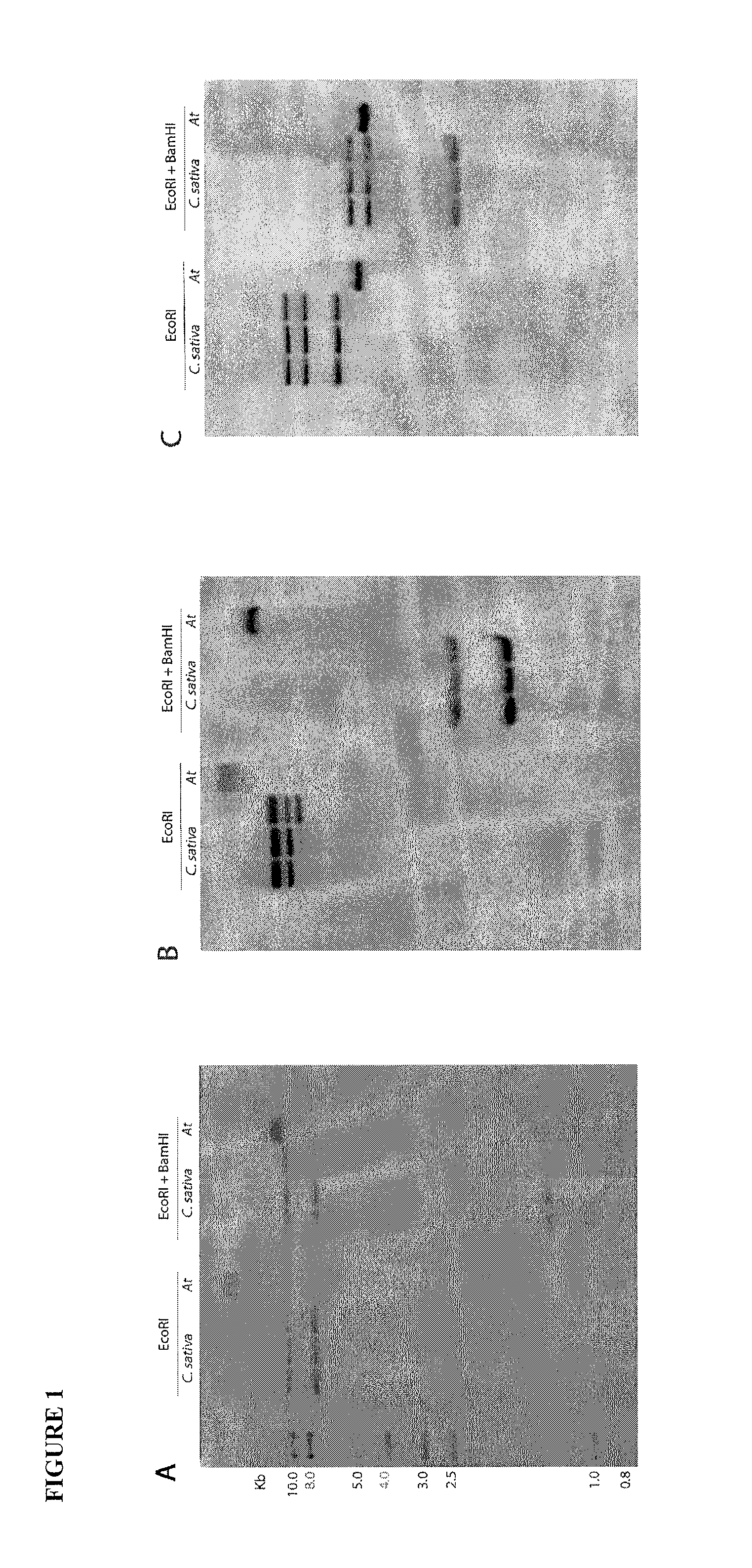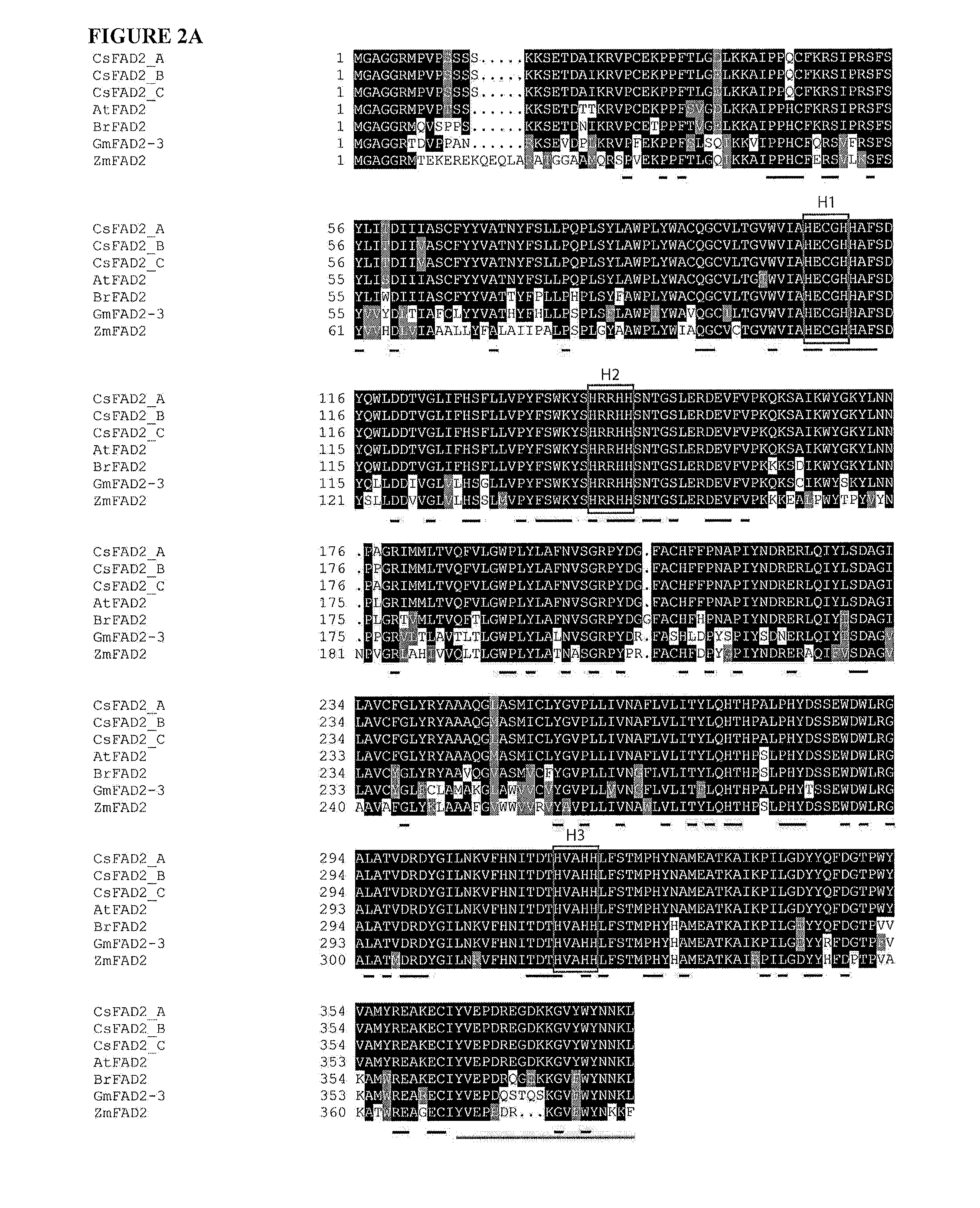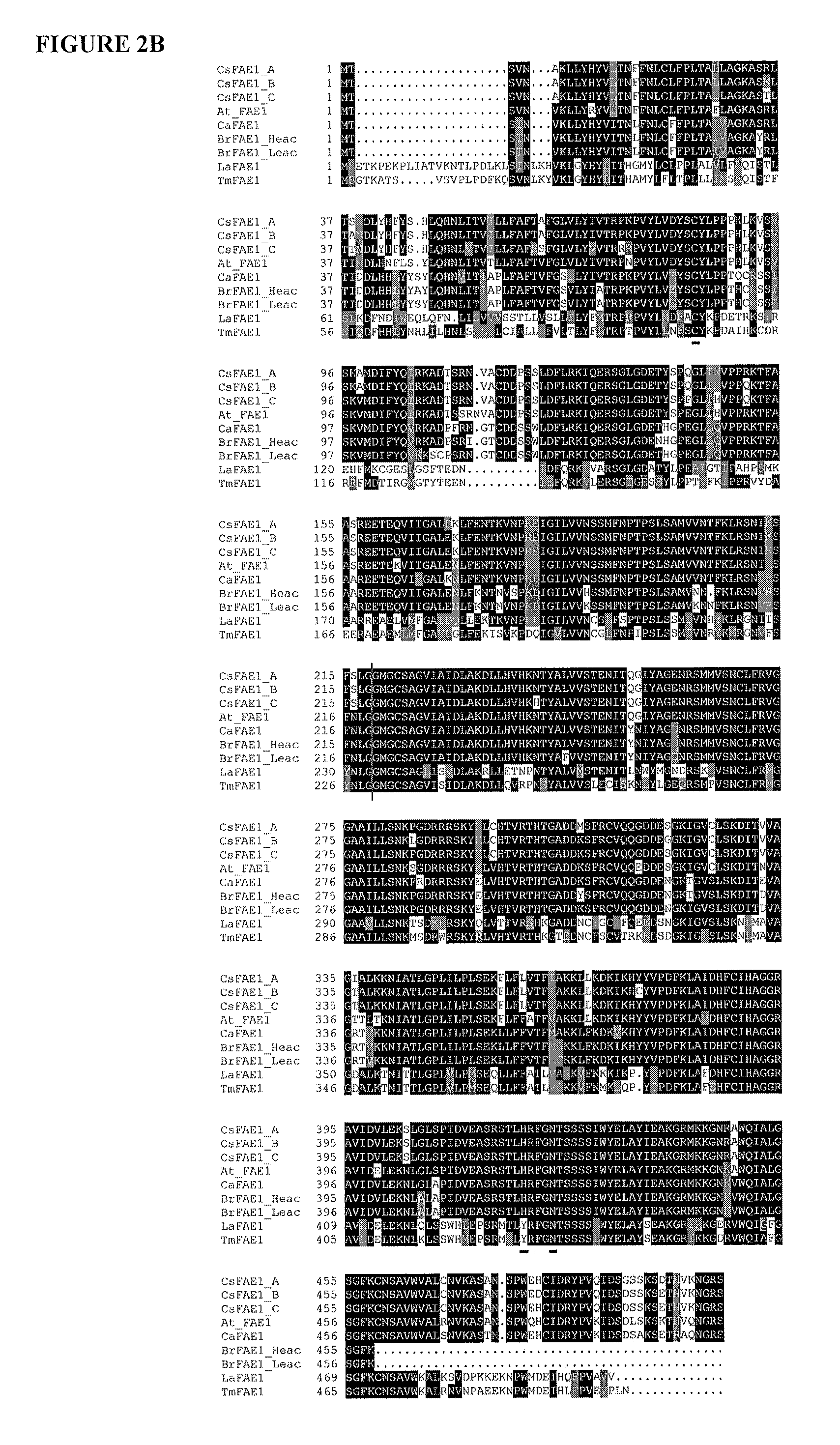Isolation and use of fad2 and fae1 from camelina
a technology of camelina and fae1, which is applied in the field of identification, isolation and use, can solve the problems of reducing marketability, increasing nox emissions, and biodiesel with a high distillation temperature that does not meet existing standards, and achieves the effects of reducing the activity of a fad2, affecting the composition of seed oil, and affecting the production of fad2
- Summary
- Abstract
- Description
- Claims
- Application Information
AI Technical Summary
Benefits of technology
Problems solved by technology
Method used
Image
Examples
example
Example 1
Methods and Materials
[0181]Camelina sativa Cs32 and Cs11, and Arabidopsis thaliana ecotype Col-0 (Table 2) seeds were germinated on Arabidopsis Growth Media (1× Murashige and Skoog (MS) mineral salts, 0.5 g / L MES, 0.8% PhytaBlend™ all from Caisson Labs, North Logan, Utah; pH5.7) and allowed to grow for ˜2 weeks under 16 / 8 hours day / night, 22 / 18° C., and ˜130 μE m−2 s−1 light intensity. Genomic DNA was isolated according to the CTAB method (Saghai-Maroof, Soliman et al. 1984) and 10 μg was digested overnight (−16 h) with EcoRI or a combination of EcoRI plus BamHI. DNA electrophoresis and blotting were carried out using standard molecular biology techniques (Tom Maniatis 1982). The probe was labelled with α-32P dCTP according to instructions of the DECAprime II kit (Ambion, Austin, Tex.). Hybridization was carried out overnight at 42° C. The blot was washed (30 minutes each) at 42° C. in 2×SSC, 0.1% SDS, followed by 55° C. in 2×SSC, 0.1% SDS, and then 55° C. in 0...
example 2
Southern Blot Hybridizations Show Multiple Copies of Genes in Camelina Sativa
[0190]As a first step to characterize genes involved in fatty acid biosynthesis, the inventors determined the copy number of FAD2 and FAE1 by Southern blot analysis. Since C. sativa is closely related to Arabidopsis thaliana (Al-Shehbaz, Beilstein et al. 2006; Beilstein, Al-Shehbaz et al. 2006; Beilstein, Al-Shehbaz et al. 2008), the inventors designed primers based on Arabidopsis that amplified conserved regions of FAD2 and FAE1. Using these primers, the inventors PCR amplified products of 225 base pairs (bp) (FAD2) and 403 by (FAE1) from Arabidopsis and from C. sativa. The C. sativa products were cloned, sequenced, and compared with Arabidopsis FAD2 and FAE1 sequences (TAIR 2009) to confirm their identities. The inventors used the C. sativa fragments as probes in Southern blot experiments (FIG. 1). Results of the Southern blots revealed three bands in C. sativa for both FAD2 (FIG. 1A) and FAE1 (FIG. 1B),...
example 3
Copies of C. Sativa FAD2 and FAE1 are Highly Similar to Each Other and to their Putative Orthologs from Arabidopsis
[0191]The inventors cloned and sequenced the full length genomic and cDNA sequences of C. sativa FAD2 and FAE1 (SEQ ID NOs: 1 to 6). Using primers designed from Arabidopsis FAD2 and Crambe abyssinica FAE1, the inventors PCR amplified a band of approximately 1.2 kb for FAD2 and 1.5 kb for FAE1 from C. sativa. For each gene, the inventors sequenced more than 60 clones. Three different versions of both FAD2 and FAE1 were recovered and designated A, B, and C. It should be noted that the A, B, and C copies were named independently for FAD2 and FAE1, and thus are not associated with a particular genome. The three copies of C. sativa FAD2 are 1155 by long, lack introns in the coding regions, are 97% identical at the nucleotide level, and encode proteins that are 99% identical in sequence (Table 1). One of the FAD2 copies contains a BamHI site, and thus this copy likely produc...
PUM
| Property | Measurement | Unit |
|---|---|---|
| acid | aaaaa | aaaaa |
| fatty acid | aaaaa | aaaaa |
| fatty acid composition | aaaaa | aaaaa |
Abstract
Description
Claims
Application Information
 Login to View More
Login to View More - R&D
- Intellectual Property
- Life Sciences
- Materials
- Tech Scout
- Unparalleled Data Quality
- Higher Quality Content
- 60% Fewer Hallucinations
Browse by: Latest US Patents, China's latest patents, Technical Efficacy Thesaurus, Application Domain, Technology Topic, Popular Technical Reports.
© 2025 PatSnap. All rights reserved.Legal|Privacy policy|Modern Slavery Act Transparency Statement|Sitemap|About US| Contact US: help@patsnap.com



